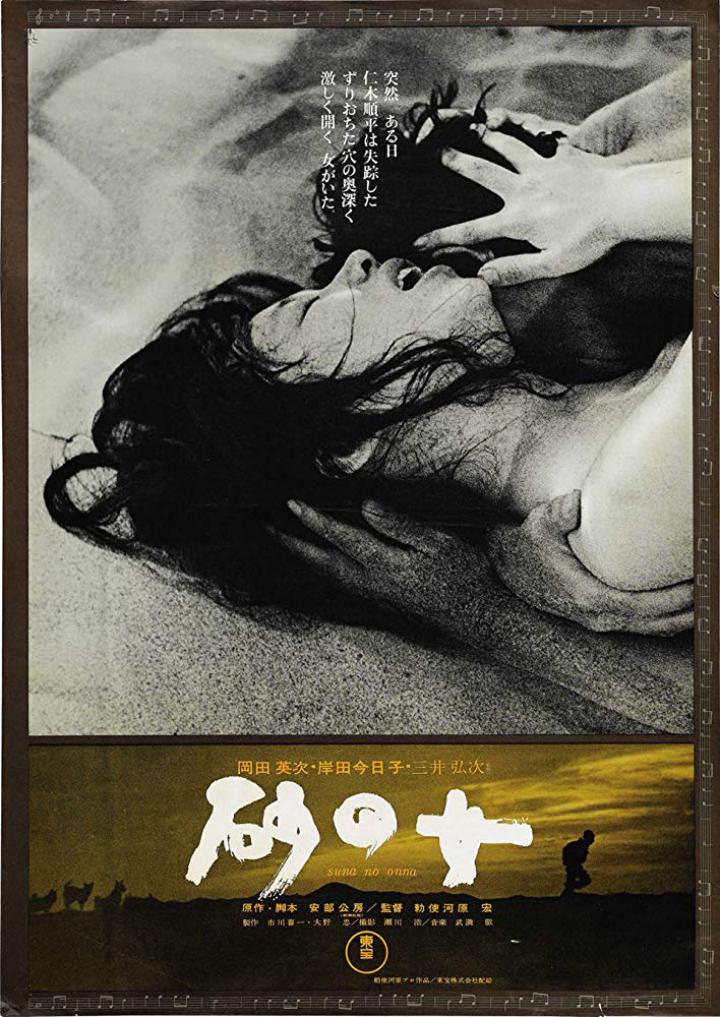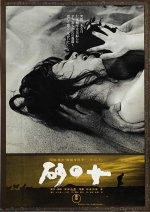Woman in the Dunes
In stunningly composed images by Teshigahara and cinematographer Hiroshi Segawa, that eroticism becomes overwhelming.
-- Michael Wilmington, Chicago Tribune
Woman in the Dunes
WOMAN IN THE DUNES (1964)
60th Anniversary Screenings
Tuesday, March 19
Five Laemmle locations
Laemmle Theatres and the Anniversary Classics Series present this month’s installment in our Anniversary Classics Abroad Series: Hiroshi Teshigahara’s Oscar-nominated erotic drama, Woman in the Dunes. Actually, the film was nominated in two separate years. In 1964, when it won the Special Jury Prize at the Cannes Film Festival, it was one of the five nominees for Best Foreign Language Film. In 1965, when the film was released in America, Teshigahara earned a nomination for Best Director. This was a milestone because he was the first Asian director ever to win that recognition from the Academy. The great Akira Kurosawa earned his only Best Director nomination a decade later, for his film Ran. Other Asian directors who have earned Oscar nominations and victories in recent years (including Ang Lee and Bong Joon Ho) owe something to Teshigahara for paving the way.
Woman in the Dunes is adapted from a novel by esteemed Japanese novelist Kobo Abe, who also contributed to the screenplay. Eiji Okada (the star of Alain Resnais’ Hiroshima Mon Amour and of Hollywood movies The Ugly American and The Yakuza) portrays an entomologist searching for a rare species of beetle in the sand dunes of a remote part of Japan. When he misses the bus to return home, he spends the night with a widow living in the dunes, portrayed by Kyoko Kishida. Eventually their relationship evolves into a more meaningful connection that transforms the life of the scientist.
The film was highly praised for the atmospheric cinematography by Hiroshi Segawa, which immerses the viewer in the spectacular setting. The film also captivated American audiences because of its frank sexuality, which was a prime attraction of international films during the 1950s and 60s, when Hollywood was still straitjacketed by the censorious Production Code. Writing in the Chicago Tribune, Michael Wilmington declared, “In stunningly composed images by Teshigahara and cinematographer Hiroshi Segawa, that eroticism becomes overwhelming.”
Other critics took note of the film’s eroticism as well as its cinematic achievements and sharp characterizations. As Roger Ebert wrote, “Woman in the Dunes retains its power because it is a perfect union of subject, style and idea.” The New York Times’ Bosley Crowther concurred that the film contains “a bewitching poetry and power.” Kevin Thomas of the Los Angeles Times called the film “a timeless contemplation of life’s essential mystery and a triumph of bold, innovative style.”
60th Anniversary Screenings
Tuesday, March 19
Five Laemmle locations
Laemmle Theatres and the Anniversary Classics Series present this month’s installment in our Anniversary Classics Abroad Series: Hiroshi Teshigahara’s Oscar-nominated erotic drama, Woman in the Dunes. Actually, the film was nominated in two separate years. In 1964, when it won the Special Jury Prize at the Cannes Film Festival, it was one of the five nominees for Best Foreign Language Film. In 1965, when the film was released in America, Teshigahara earned a nomination for Best Director. This was a milestone because he was the first Asian director ever to win that recognition from the Academy. The great Akira Kurosawa earned his only Best Director nomination a decade later, for his film Ran. Other Asian directors who have earned Oscar nominations and victories in recent years (including Ang Lee and Bong Joon Ho) owe something to Teshigahara for paving the way.
Woman in the Dunes is adapted from a novel by esteemed Japanese novelist Kobo Abe, who also contributed to the screenplay. Eiji Okada (the star of Alain Resnais’ Hiroshima Mon Amour and of Hollywood movies The Ugly American and The Yakuza) portrays an entomologist searching for a rare species of beetle in the sand dunes of a remote part of Japan. When he misses the bus to return home, he spends the night with a widow living in the dunes, portrayed by Kyoko Kishida. Eventually their relationship evolves into a more meaningful connection that transforms the life of the scientist.
The film was highly praised for the atmospheric cinematography by Hiroshi Segawa, which immerses the viewer in the spectacular setting. The film also captivated American audiences because of its frank sexuality, which was a prime attraction of international films during the 1950s and 60s, when Hollywood was still straitjacketed by the censorious Production Code. Writing in the Chicago Tribune, Michael Wilmington declared, “In stunningly composed images by Teshigahara and cinematographer Hiroshi Segawa, that eroticism becomes overwhelming.”
Other critics took note of the film’s eroticism as well as its cinematic achievements and sharp characterizations. As Roger Ebert wrote, “Woman in the Dunes retains its power because it is a perfect union of subject, style and idea.” The New York Times’ Bosley Crowther concurred that the film contains “a bewitching poetry and power.” Kevin Thomas of the Los Angeles Times called the film “a timeless contemplation of life’s essential mystery and a triumph of bold, innovative style.”
Genre
Drama,
Thriller,
Auteur Cinema,
Anniversary Classics,
Erotica
Runtime
147
Language
Japanese
Director
Hiroshi Teshigahara
Writer(s)
Kōbō Abe
Cast
Eiji Okada,
Kyōko Kishida
Awards:
Nominee, Best Director, Academy Awards
Nominee, Best Foreign Language Film, Academy Awards
Nominee, Palme d’Or, Cannes Film Festival
Winner, Jury Prize, Cannes Film Festival
MOREPlayed at
Newhall 3.19.24 - 3.19.24
Claremont 5 3.19.24 - 3.19.24
Royal 3.19.24 - 3.19.24
Glendale 3.19.24 - 3.19.24
Town Center 5 3.19.24 - 3.19.24
Woman in the Dunes Get Tickets
There are currently no showtimes for this film. Please check back soon.

